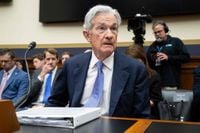Federal Reserve Chairman Jerome Powell testified before the House Financial Services Committee on June 24, 2025, delivering a comprehensive update on the U.S. economy and monetary policy. His testimony, closely watched by markets and policymakers alike, underscored the Fed's cautious stance amid a mix of economic strength and lingering uncertainties, particularly surrounding tariffs and inflation.
Powell began by affirming that the United States is not in a recession, emphasizing that "many paths are possible" for the economy’s trajectory. He highlighted that if inflation turns out to be less intense than currently expected or if the labor market shows signs of weakening, the Federal Reserve would consider cutting interest rates sooner. Conversely, if inflation and employment remain robust, rate cuts might be postponed. This balanced approach reflects the Fed’s commitment to adapting its policies based on evolving economic data.
One of the central themes of Powell's testimony was the impact of tariffs imposed by the U.S. administration. He noted that Fed projections anticipate inflation to rise due to these tariffs, but admitted that the extent to which these costs will be passed on to consumers remains uncertain. "We do expect to show up — tariff inflation to show up more," Powell told the committee, "but I want to be honest, we really don't know how much of that's going to be passed through to the consumers. We just don't know. And we won't know until we see it. It could be lower than we expect; it could be higher. We have to wait and see, which is kind of what we're doing." This wait-and-see approach stems from the unpredictable nature of tariff impacts on prices and economic activity.
Powell’s testimony also touched on geopolitical developments, including the recent ceasefire between Israel and Iran. While this move brought some relief, Powell cautioned that it is "too early to determine what the economic impact will be at the moment," adding that the Fed is closely monitoring the situation. Such international uncertainties contribute to the Fed’s prudent stance.
Despite these challenges, the Fed Chair described the U.S. economy as "solid," noting it is near full employment with inflation somewhat above the 2% target. He stressed the importance of maintaining price stability to support long-term strong labor market conditions. "Without price stability, we cannot achieve long periods of strong labor market conditions," Powell explained.
On the subject of interest rates, the Fed has held the benchmark rate steady at 4.25% to 4.50% since the June 18 Federal Open Market Committee (FOMC) meeting. Markets had been speculating about a possible rate cut as early as July, but Powell put those expectations on hold. "There is no rush" regarding a rate cut, he said, emphasizing that the economy and job market remain strong. He added, "If the job market weakens meaningfully to a worrisome level, it will affect the decision." This cautious tone cooled market optimism for an imminent easing of monetary policy.
Nevertheless, within the Fed, there is some openness to cutting rates sooner rather than later. Fed Governor Christopher Waller, in an interview before the testimony, advocated for considering a rate cut at the July meeting, warning against waiting until the labor market deteriorates significantly. Similarly, Fed Governor Michelle Bowman expressed support for lowering rates at the next meeting to better align policy with the neutral setting and sustain a healthy labor market. These perspectives highlight a nuanced debate within the Fed about the timing of monetary easing.
Powell also addressed the political pressures surrounding monetary policy. Despite repeated calls from President Donald Trump to cut rates quickly, Powell emphasized that the Fed does not consider politics in its decisions. "We don't consider politics in making rate decisions," he stated firmly. This independence is crucial for maintaining the credibility of the central bank.
Tariffs remain a particularly contentious issue. President Trump has made it clear that he intends to use tariffs to support American producers and the U.S. economy, especially ahead of the November 2024 presidential election. In 2024, Mexico, China, and Canada accounted for 42% of total U.S. imports, with Mexico alone exporting $466.6 billion worth of goods to the U.S., according to the Census Bureau. Trump’s strategy involves focusing tariffs on these key trading partners and using the revenue generated to lower personal income taxes.
However, Powell warned that tariffs contribute to inflationary pressure and weigh on economic activity. He explained that while the Fed expects tariff-induced inflation to become more apparent, the timing and magnitude remain uncertain. This uncertainty has led the Fed to adopt a cautious approach, holding rates steady while gathering more data.
Market reactions to Powell’s testimony were measured. The U.S. Dollar Index hovered near 98.00, losing about 0.3% on the day, with the dollar weakening against several major currencies including the Euro, British Pound, and Australian Dollar. The market’s modest response reflects the balancing act between expectations of future rate cuts and the Fed’s current cautious stance.
Jerome Powell’s leadership of the Federal Reserve has been marked by navigating complex economic landscapes. First appointed chair in 2018 and reappointed in 2022 for a second term through 2026, Powell has faced significant challenges including trade tensions, geopolitical risks, and evolving inflation dynamics. His testimony on June 24 reaffirmed the Fed’s commitment to its dual mandate of price stability and maximum employment, while carefully managing the uncertainties ahead.
As the Fed continues to monitor economic indicators, tariffs, and geopolitical developments, the path of U.S. monetary policy remains data-dependent. For now, Powell’s message is clear: patience and prudence are paramount. The Fed stands ready to adjust policy when warranted but will not rush decisions in the face of uncertainty, striving to balance risks and support sustained economic growth.

